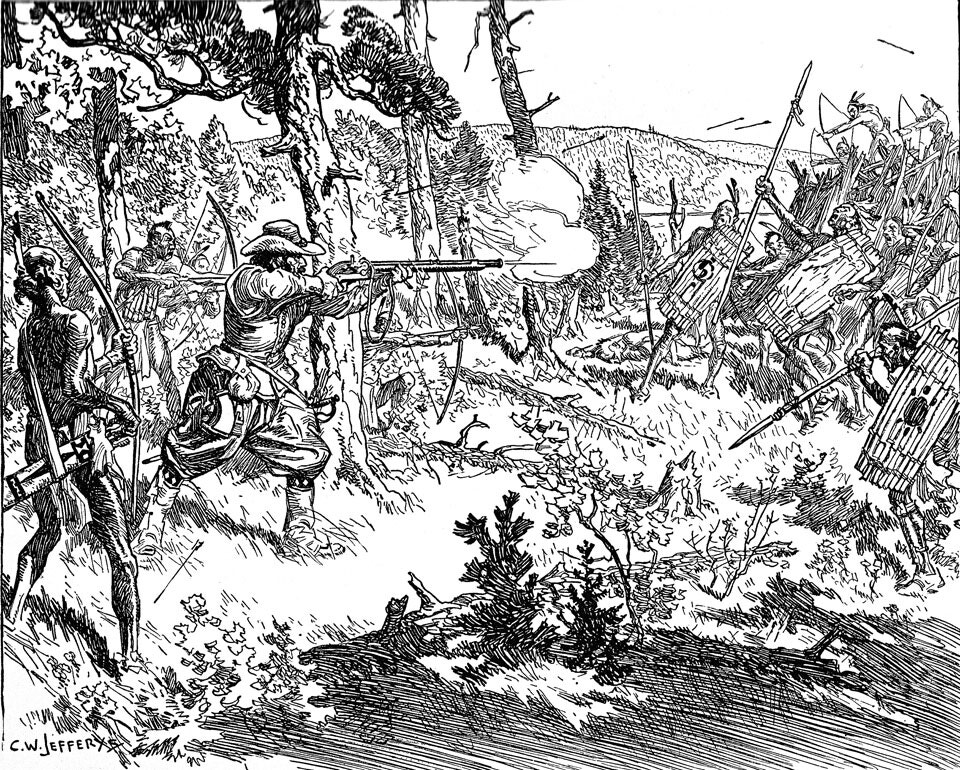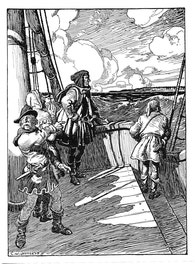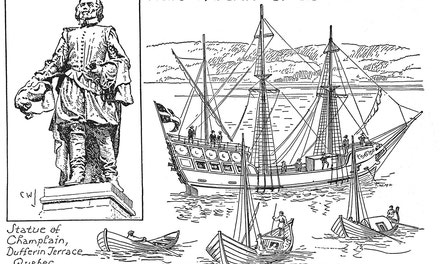Champlain's Fight With the Iroquois, 1609
- Credit: Library and Archives Canada, Acc. No. 1972-26-1415
Copyright: Expired
- Remarks
C.W. Jefferys' notes about this picture in Dramatic Episodes in Canada's Story
It was Champlain's great desire to explore the country whence came the great river on whose banks he had planted the settlement of Quebec, and to search for a passage which would lead to the Western Sea. No one dreamed then of the many miles that stretched between the shores they had already discovered and the distant Pacific Ocean. The great lakes and rivers, the broad prairies, the enormous mountains, all were unknown, and only slowly, through long years and by the toilsome journeys of many explorers was the way found. Champlain had to make friends of the Algonquin and Huron Indians around him, so that they would guide him into this unknown land, and allow him to make settlements and build trading posts among them. To gain their good-will he had to promise to help them in their war with the Iroquois south of the lakes, who were their deadly enemies.
So it was in the summer of 1609, the next after the founding of the city of Quebec, that Champlain joined a party of his Indian allies on a raid into the Iroquois country. They travelled up the St. Lawrence and the river Richelieu to the lake which is now called by his name. Here they met their enemies. Both parties landed on the western shore and prepared for battle. The Iroquois sheltered themselves behind a rude stockade of tree trunks, from which they came out to attack Champlain's Indians. He, with two other Frenchmen, had hidden themselves in the woods, so as to surprise the Iroquois by their sudden appearance. Led by three chiefs, decked with tall plumes of feathers fastened in their hair, the Iroquois advanced, and the arrows flew thick on both sides. Champlain stepped forward in sight of the Iroquois, who ceased firing in their astonishment. Taking careful aim at one of the chiefs, he fired his arquebus, which he tells us he had loaded with four bullets, while at the same time his two companions fired from the woods. Two of the chiefs fell dead and a third was wounded. The Iroquois, who had never seen a white man, and knew nothing of firearms, became panic-stricken and fled. It was an easy victory, but the attack drew upon the French the hatred of the Iroquois, and for more than a hundred years the settlers of Canada suffered all the horrors of savage warfare for this alliance of Champlain with the Northern Indians.
The accompanying illustration represents Champlain dressed in the costume of a musketeer of the early seventeenth century. Sometimes light steel armour, such as breastplates and thigh-pieces, was worn; but probably Champlain, travelling in summer and by canoe in the wilderness, wore only a sleeveless outer coat of thick buff-coloured leather, an under coat or shirt with sleeves, loose cloth knee-breeches, buckskin leggings and moccasins, and a broad brimmed hat. His heavy and clumsy weapon is an arquebus, an early form of the musket, which was loaded at the muzzle and fired by means of a slow-burning fuse, a long cord of rope or tow, the lighted end of which was brought into contact with the powder at the breech by pulling a spring trigger. A bag of bullets and two powder flasks hang from his belt. These early fire-arms were slow and cumbrous in their action; they took several minutes to prime, load and fire, and the kick was so heavy that sometimes it dislocated the shoulder or collar-bone of the shooter. Compared with them, the Indian's bow and arrows were quick-firing weapons. At first the Indians were surprised and panic-stricken by the noise, the smoke and flame, and the penetrating power of the white man's weapons; but they soon realized the superior efficiency of their own arms, and from the shelter of the forest, in many a surprise attack, they were able to pour in a continuous and silent flight of arrows upon the French settlers before these could return the fire. It was not until the musket was improved by substituting a flint and steel for the slow-burning fuse or '(match,' about 1670, that the whites were able to gain any decided advantage over the Indians in bush fighting. It may not be generally known that the Indians wore armour; but Champlain and the early writers frequently refer to their shields of wood, or, in the West, of buffalo hide, and speak of their chest and leg protectors, made of sticks woven together with cotton fibre, roots or sinews. In the picture, some of the Indians wear body-pieces of bark or wicker.
C.W. Jefferys' notes about this picture in Canada's Past in Pictures
It was Champlain's great desire to explore the country whence came the great river on whose banks he had planted the settlement of Quebec, and to search for a passage which would lead to the Western Sea. No one dreamed then of the many miles that stretched between the shores they had already discovered and the distant Pacific Ocean. The great lakes and rivers, the broad prairies, the enormous mountains, all were unknown, and only slowly, through long years and by the toilsome journeys of many exploreys was the way found. Champlain had to make friends of the Algonquin and Huron Indians around him, so that they would guide him into this unknown land, and allow him to make settlements and build trading posts among them. To gain their good will he had to promise to help them in their war with the Iroquois south of the lakes, who were their deadly enemies.
So, in the summer of 1609, the year after the founding of Quebec, Champlain joined a party of his Indian allies on a raid into the Iroquois country. They travelled up the St. Lawrence and the river Richelieu to the lake which is now called by his name. Here they met their enemies. Both parties landed on the western shore and prepared for battle. The Iroquois sheltered themselves behind a rude stockade of tree trunks, from which they came out to attack Champlain's Indians. He, with two other Frenchmen, had hidden themselves in the woods, so as to surprise the Iroquois by their sudden appearance. Led by three chiefs, decked with tall plumes of feathers fastened in their hair, the Iroquois advanced, and the arrows flew thick on both sides. Champlain stepped forward in sight of the Iroquois, who ceased firing in their astonishment. Taking careful aim at one of the chiefs, he fired his arquebus, which he tells us he had loaded with four bullets, while at the same time his two companions fired from the woods. Two of the chiefs fell dead and a third was wounded. The Iroquois, who had never seen a white man, and knew nothing of firearms, became panic-stricken and fled. It was an easy victory, but the attack drew upon the French the hatred of the Iroquois, and for more than a hundred years the settlers of Canada suffered all the horrors of savage warfare for this alliance of Champlain with the northern Indians.
The picture shows Champlain dressed in the costume of a musketeer of the early seventeenth century. Sometimes light steel armour, such as breastplates and thigh-pieces, was worn; but probably Champlain, travelling in summer and by canoes in the wilderness, wore only a sleeveless outer coat of thick buff-coloured leather, an under coat or shirt with sleeves, loose cloth knee-breeches, buckskin leggings and moccasins, and a broad-brimmed hat. His heavy and clumsy weapon is an arquebus, an early form of the musket, which was loaded at the muzzle and fired by means of a slowburning fuse, a long cord of rope or tow, the lighted end of which was brought into contact with the powder at the breech by pulling a spring trigger. A bag of bullets and two powder flasks hang from his belt. These early firearms were slow and cumbrous in their action; they took several minutes to prime, load and fire, and the kick was so heavy that sometimes it dislocated the shoulder or collar-bone of the shooter. Compared with them, the Indian's bow and arrows were quick-firing weapons. At first the Indians were surprised and panic-stricken by the noise, the smoke and flame, and the penetrating power of the white man's weapon; but they soon realized the superior efficiency of their own arms, and from the shelter of the forest, in many a surprise attack, they were able to pour a continuous and silent flight of arrows upon the French settlers before these could return the fire. It was not until the musket was improved by substituting a flint and steel for the slow-burning fuse or "match" that the whites were able to gain any decided advantage over the Indians in bush fighting. It may not be generally known that the Indians wore armour; but Champlain and the early writers frequently refer to their shields of wood. or, in the West, of buffalo hide, and speak of their chest and leg protectors, made of sticks woven together with cotton fibre, roots or sinews. In the picture, some of the Indians carry wooden shields decorated with their totems and wear body-pieces made of bark or wicker.
C.W. Jefferys' notes about this picture in The Picture Gallery of Canadian History Vol. 1
The picture shows Champlain dressed in the costume of a musketeer of the early seventeenth century. Sometimes light steel armour, such as breastplates and thigh-pieces, was worn; but probably Champlain, travelling in summer and by canoes in the wilderness, wore only a sleeveless outer coat of thick buffcoloured leather, an under coat or shirt with sleeves, loose cloth knee-breeches, buckskin leggings and moccasins, and a broadbrimmed hat. His heavy and clumsy weapon is an arquebus, which was loaded at the muzzle and fired by means of a slow-burning fuse, a long cord of rope or tow, the lighted end of which was brought into contact with the powder at the breech by pulling a spring trigger. A bag of bullets and two powder flasks hang from his belt. These early firearms were slow and cumbrous in their action; they took several minutes to prime, load and fire, and the kick was so heavy that sometimes it dislocated the shoulder or collar-bone of the shooter. Compared with them, the Indian's bow and arrows were quick-firing weapons. At first the Indians were surprised and panic-stricken by the noise, the smoke and flam e, and the penetrating power of the white man's weapon; but they soon realized the superior efficiency of their own arms, and from the shelter of the forest, in many a surprise attack, they were able to pour a continuous and silent flight of arrows upon the French settlers before these could return the fire. It was not until the musket was improved by substituting a flint and steel lock, acting on a spring trigger, for the slow-burning fuse or "match," about 1670, that the whites were able to gain any decided advantage over the Indians.
It may not be known generally that Indians wore armour; but Champlain and other early explorers frequently refer to their shields of wood, and speak of their chest and leg protectors, made of reeds, or of sticks woven together with cotton fibre, roots or sinews. In the west shields of dried buffalo hide were used.
Publication References
- Jefferys, Charles W. 1930 Dramatic Episodes in Canada's Story, p.15
-
Jefferys, C.W. Another historical series: 16 fine drawings of dramatic milestones in Canada’s story. Toronto, Star Newspaper Service, 1930?.
- Jefferys, Charles W. 1934 Canada's Past in Pictures, p.24
- Jefferys, Charles W. 1942 The Picture Gallery of Canadian History Vol. 1 , p.91
-
Long, Morden H. A History of the Canadian People: vol. 1, New France. Toronto, Ryerson, 1942. 376 p. Illus.
-
Walker, Paul. C.W. Jefferys and images of Canadian identity in School Textbooks Kingston, Ont., Queen’s University, 1990. Masters of Art thesis.130 p. Illus.
- “Early Canada Historical Narratives -- CHAMPLAIN & THE FUR TRADE.” Accessed July 23, 2017. http://www.uppercanadahistory.ca/finna/finna2.html.
- Begbie Contest Society. “Canadian primary sources in the classroom: New France.” July 2017, 109 p. Illus. http://www.begbiecontestsociety.org/NewFrance.htm Accessed July 27, 2017.





Comments